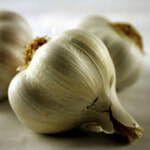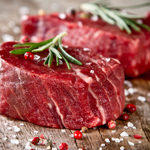Table of Contents
The chicken is one of the world’s most ubiquitous birds. Whether you’re in the small jungle villages of northern Thailand, the harsh, unforgiving outback of central Australia or the lush green countryside of Ireland, you’re likely to find domesticated chickens clucking away. Indeed, the global population of chickens now exceeds 20 billion – and that number continues to rise yearly.
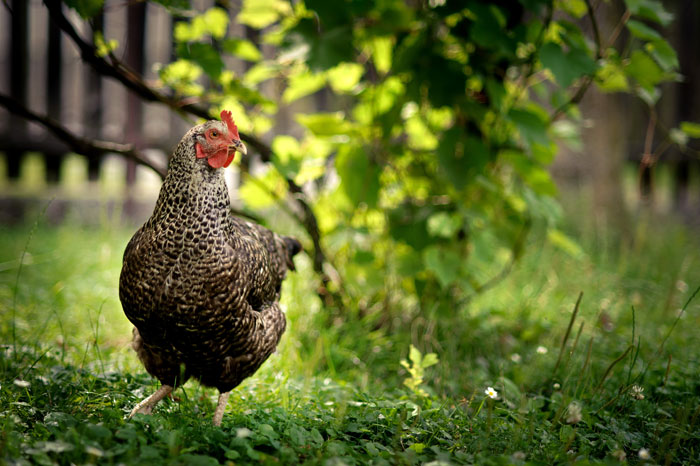
Can you imagine a world without the humble chicken?
The overwhelming majority of these chickens are, of course, kept for their eggs and meat. I’ve already written about the health benefits of eggs on this website, so now I want to focus on the health benefits of the meat.
So, let’s start with the basics…
Why Is Chicken Good for You?

According to NutritionData, half of a cooked chicken breast is:
While not quite as nutritious as beef or lamb, chicken is still a healthy meat to consume. It provides small quantities of almost all the essential nutrients our bodies require to function properly, including certain nutrients (such as vitamin B12) that cannot be obtained from plant foods.
Moreover, like all meats, chicken is likely to contain nutrients that are currently undiscovered by science. For all we know, the data above could be the tip of the iceberg!
Did you know?
While they might not be the most intelligent animals on Earth, chickens do display signs of higher sentience. The average chicken can perform over 30 types of vocalization of which we are aware, including different alarm calls for certain types of predator. Chickens also remember and recognize approximately 100 individuals, and – unlike human children – are even able to understand that objects that are taken away from them still exist.
Additionally, hens display signs of empathy for their chicks. In fact, many ancient cultures acknowledged hens as highly affectionate and loving mothers – so much so, in fact, that being called a “hen” was a huge compliment to human females. And to think, these gentle and unassuming birds are the closest living relative to the most ferocious and feared dinosaur of all: the tyrannosaurus rex!

*Cluck*
Research into the Health Benefits of Chicken
One of the World’s Best Protein Sources
Half of a cooked chicken breast contains approximately 29.2 grams of protein, which is a whopping 58% of our daily value (DV). This means that one chicken breast supplies us with enough protein for the whole day!
Better still, chicken protein is a complete protein, meaning it contains the 9 essential amino acids that our bodies cannot manufacture themselves, and which need to be obtained from food sources. Chicken protein also scores an optimal 1.0 rating on the Protein Digestibility-Corrected Amino Acid Score (PDCAAS), an index that evaluates the digestibility of protein (1).
To put it in simpler terms, chicken meat is a perfect protein source.

Need more protein? Eat this
We need protein, of course, to provide structure and strength to our cells and tissues. However, protein also performs countless other biological roles, including controlling important biochemical reactions, supporting the immune system, aiding hormone and metabolism function, and regulating cell division.
When deficient in protein, we can suffer from muscle and joint pain, chronic fatigue, low moods, unstable blood sugar levels and other undesirable symptoms. Consequently, it is important that we obtain enough complete, highly-digestible protein from whole foods sources like chicken to maintain optimum health.
Reduces the Risk of Homocysteine-Related Heart Disease
Homocysteine is a common amino acid found in the blood, but elevated levels of it are associated with atherosclerosis and other markers of heart disease. However, studies have shown that chicken can reduce levels of homocysteine in the bloodstream, thus decreasing our risk of the Western’s world’s number one “silent killer.”
These results are somewhat ironic, since homocysteine is mostly acquired from the consumption of meat! It just goes to show that nothing bad really comes from eating natural whole foods. Any nutrients or compounds in these foods that are shown to cause problems when tested in isolation almost always end up being suppressed, if not outright neutralized, by other nutrients when assessed from a more holistic perspective.
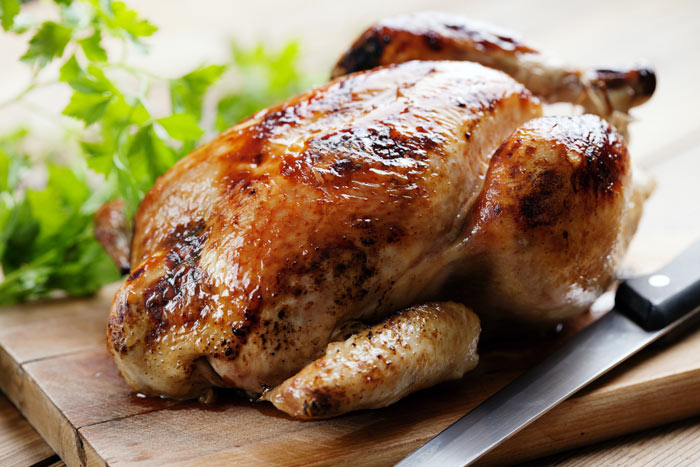
There’s a reason they are called “whole” foods
Packed with Brain-Boosting B Vitamins
Half of a cooked chicken breast contains around 71.4 milligrams of choline, a B vitamin that is a constituent of lecithin. Though there is no DV established for choline, since it was only recognized as an essential nutrient in 1998 and its roles in the body are still not fully understood, it’s safe to say that 71.4 milligrams is a generous amount choline. Indeed, eating the whole breast will supply us with more choline than one large egg (eggs are considered the most concentrated sources of choline) (4).
We’ve already learned from the previous study that choline can reduce serum homocysteine levels, but choline’s real benefits stem from its effects on cognitive health. For example, check out what the following studies discovered about this rather mysterious nutrient:
However, choline isn’t the only B vitamin in chicken that possesses brain-boosting properties. Chicken is one of the greatest natural sources of niacin, or vitamin B3, which guards us from Alzheimer’s disease, depression and other cognitive issues. Likewise, the vitamin B6 in chicken is involved in the process of manufacturing serotonin and norepinephrine – two chemicals that transmit signals to the brain.
The bottom line, then, is that chicken is packed with nutrients that are good for our brains. Chicken meat and eggs are an especially important food for pregnant mothers, since the B vitamins they contain are essential for the proper neurological development of the child.
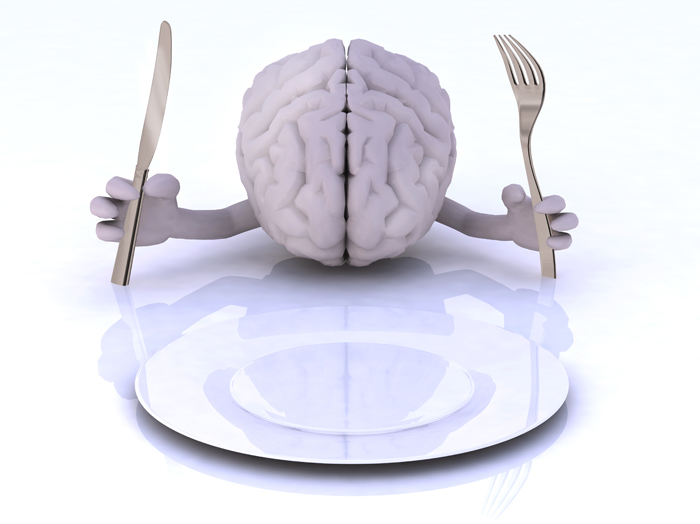
If I were an anthropomorphic brain, I would eat chicken to stay healthy
Did you know?
While most people prefer eating the muscle of the chicken, such as the breast or wings, other parts of the bird are often more nutritious. The liver of the chicken, for instance, tends to contain more brain-boosting B vitamins (including the all-important choline), as well as more iron, zinc and vitamin A, than the muscle. Moreover, the bones of the chicken can be simmered into a stock or broth that is well-known for its healing properties.
I know it can be difficult to overcome our aversion to the appearance, taste and idea of consuming non-muscle animal parts. However, this aversion merely reflects our detachment from the natural world. Our paleolithic ancestors greatly valued organ meats for their nutritional power, and seldom let any part of the animal go to waste.
Chicken Fat: A Source of Lutein and Zeaxanthin
Ever noticed that chicken skin is often yellow? This is because the fat within it contains variable (but usually large) quantities of lutein and zeaxanthin, two potent antioxidants that occur in high concentrations in the human eye (9). In fact, the main job of lutein and zeaxanthin is to protect the eyes from damage associated with high-energy light waves, including ultraviolet rays from sunlight, and countless studies prove that these antioxidants possess vision-boosting properties.
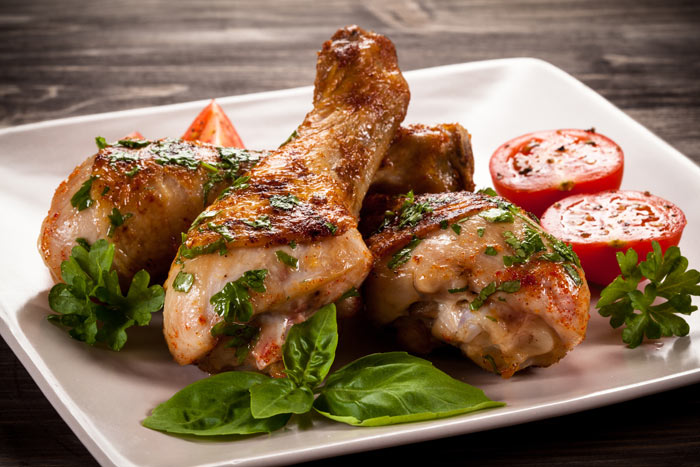
The skin of the drumsticks is an especially good source of fat
It’s worth noting that the diet of the chicken plays a vital role in the quality of its fat. A pasture-raised chicken that is allowed to enjoy a natural diet of high-carotenoid plant foods, such as marigolds and dandelions, will have more lutein and zeaxanthin in its fat than a chicken fed an unnatural diet of grain and corn. Moreover, don’t forget that toxins accumulate in the fat. If you must eat conventionally-raised chickens rather than pasture-raised ones, I recommend you avoid eating the fat completely.
Did you know?
It turns out that chickens have really good vision. Unlike humans, who only have three basic color cones in their retina (red, yellow and blue), chickens have ultra-violet (UV) cones that let them view more colors and shades than humans can. Aside from helping them to find bugs, seeds and berries among the non-UV reflecting grass and soil, these UV cones allow chickens to discern which of their chicks are healthiest according to the quality of their feathers.
On the negative side, the night vision of chickens is poor, since they evolved after the dinosaur age and haven’t spend millions of years as nocturnal animals.
Rich in Bone-Building Phosphorus
Chicken is an unusually good source of phosphorus, an essential trace mineral and an important constituent of human bones. In fact, more than half of all bone is made from phosphate (the inorganic chemical our bodies create from phosphorus), making phosphorus the second most profuse mineral in the body after calcium.
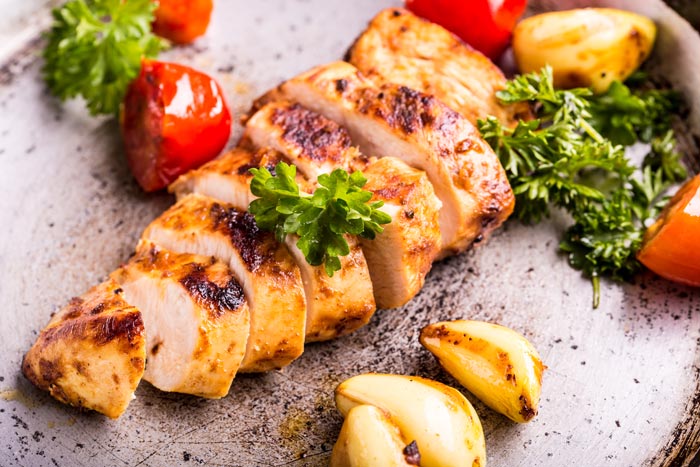
Chicken is great for the bones
As you’ve probably guessed, phosphorus plays an important role in the maintenance of teeth and bones, as well as the overall growth process. It works in conjunction with calcium to build strong bones, improve the health of our gums and tooth enamel, and relieve the symptoms of serious bone diseases, such as osteoporosis. However, phosphorus also facilitates effective digestion, maintains kidney function, aids in the creation of proteins, contributes to the cell repair process and more.
Summary of Pasture-Raised Chicken’s Benefits
As well as being one of the finest natural sources of cell-building protein, chicken meat is a potent B vitamin complex and contains a lot of compounds that improve mental health. It is also rich in a number of essential vitamins and minerals, including nutrients that suppress harmful amounts of homocysteine in our bloodstream.
Furthermore, the fat of a healthy, pasture-raised chicken – which is mostly contained in the skin – is usually packed with varying levels of the vital antioxidants, lutein and zeaxanthin, which enhance visual performance and shield us from age-related vision disorders.
Selecting and Storing Chicken
When possible, chicken should be sourced from certified organic farms that raise their birds in pastures. These farms typically label their chickens as “pasture-raised,” indicating that the birds spend most of their time in outdoor fields. Most organic farms have websites in which you can view videos and images of their livestock areas, letting you judge whether their standards suit your needs.
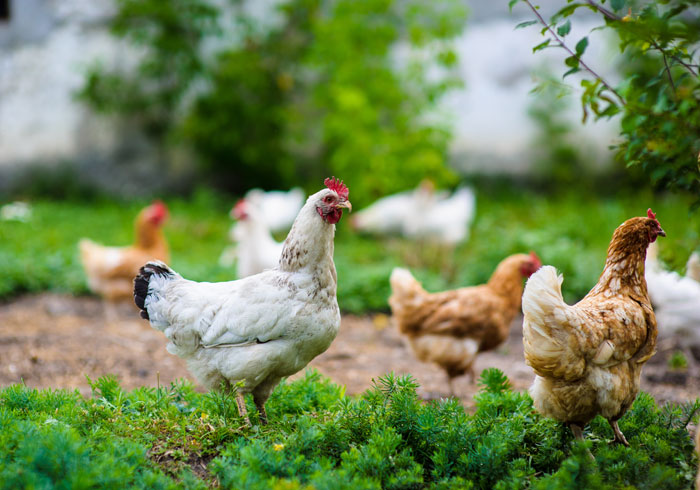
Pasture-raised chickens are the happiest chickens
If you must purchase chicken from conventional supermarkets, favor whole chickens that have robust shapes and rounded breasts. The chicken should be somewhat malleable when gently pressed, and should have no offensive odors. Frozen chickens should be frozen solid when sold, and without liquid in the packaging (this indicates that the chicken has been defrosted and refrozen).
Chicken should be refrigerated at all times, preferably in the coldest parts of the fridge. Keep the packaging intact for as long as possible to minimize the amount of handling. If you want to freeze the chicken, first remove it from its packaging, then wash it, dry it and store the individual chicken parts in aluminum foil. They will keep in the freezer for about a year.
Cooking Chicken
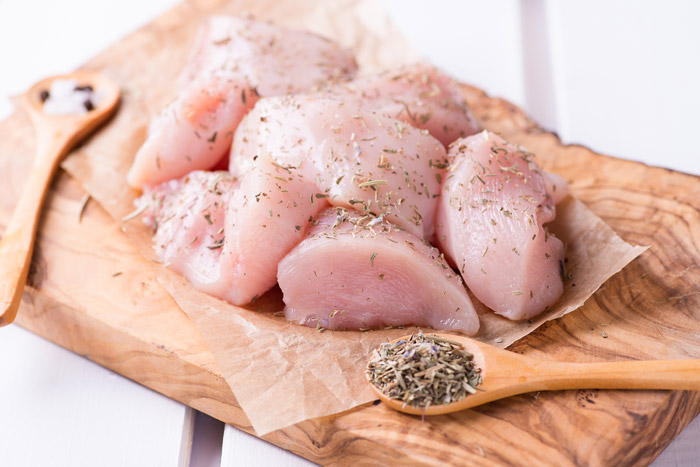
Raw chicken: bad for stomachs
Raw chicken (including raw organic, pasture-raised chicken) often contains harmful bacteria, such as the notorious Salmonella. Therefore, chicken should always be cooked thoroughly before consumption. Generally speaking, the chicken is cooked when the meat is white on the inside and the juices run clear.




